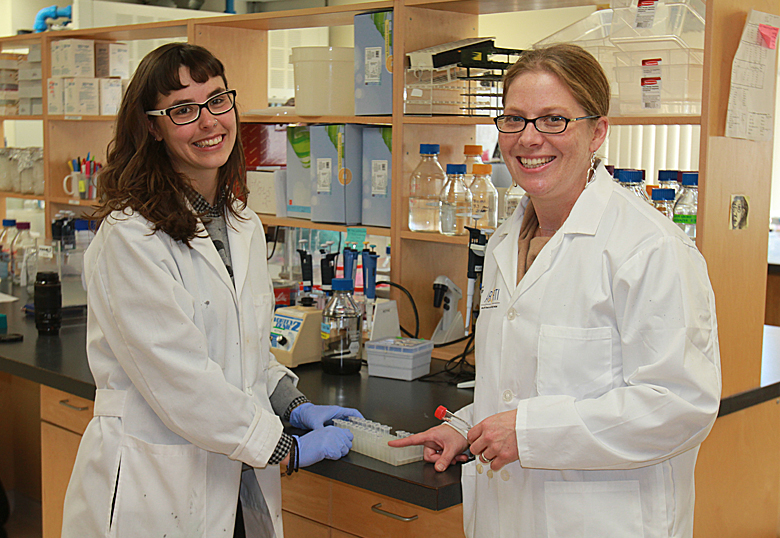Dr. Laura Keffer-Wilkes (MSc ’12, PhD ’16) spent four years conducting research into the function of a protein important for gene expression, and her hard work and persistence has paid off.
A few days before receiving her doctorate at the University of Lethbridge’s fall convocation ceremonies, Keffer-Wilkes learned that a research paper, on which she is the lead author, had been accepted for publication in the Proceedings of the National Academy of Sciences (PNAS) in the United States. Other authors on the paper, titled The RNA modification enzyme TruB is a tRNA chaperone, include her co-worker, Dr. Govardhan Reddy Veerareddygari, and her supervisor, Dr. Ute Kothe, with the Alberta RNA Research and Training Institute at the U of L.
“I’ve had a few papers published already but I’ve been second or third author. This paper represents four years of my life so it’s pretty big,” says Keffer-Wilkes. “It was a lot of work, a lot of effort and PNAS is huge. It’s a high-impact journal, so it’s an honour.”

“This is a tremendous accomplishment for Laura, for me and for my entire lab. It represents many years of work and will change the thinking in our field of RNA research,” says Kothe, adding they have solved a mystery about proteins that make small chemical alterations to RNA (ribonucleic acid). “To everyone’s surprise, we found out that this protein has a second, even more crucial function. The enzyme helps in folding RNA into the correct shape, so it acts as an RNA chaperone that assists RNA in its maturation.”
Their finding might just represent the tip of the iceberg as it suggests that many proteins in the cell are likely also RNA chaperones. These proteins are found in humans, where alterations in these proteins lead to diseases.
“Maybe the RNA chaperone function of many proteins is important for human health. We certainly need to investigate this more closely,” says Kothe.
“We are a lab that studies functional RNAs. These are RNAs that do jobs in the cell. What I study specifically is called transfer RNA or tRNA,” says Keffer-Wilkes. “These molecules bring amino acids to the protein-building factory (ribosome) of the cell. In order to do that, they need to have a very specific shape and stability. In order to maintain a specific shape and stability, the RNA is modified by specialized proteins called enzymes. We study the enzymes, specifically TruB, that make these modifications on tRNA and how they work.”
In the late 1990s, James Ofengand, an RNA researcher, proposed that the enzyme TruB acts as a tRNA chaperone in the cell. TruB modifies the tRNAs in a cell and Ofengand speculated that TruB was also involved in helping to protect or fold the tRNA.
“No one had ever actually tested this hypothesis. We are the first people in many years to actually sit down and figure out how and possibly why this protein is acting as a tRNA chaperone,” Keffer-Wilkes says. “We’ve shown that TruB is indeed acting as a tRNA chaperone. Surprisingly, it doesn’t need the modification activity, but binding to tRNA is critical for its chaperone function.”
At the start, DNA gets photocopied into messenger RNA, which then gets read in the ribosome where tRNA decodes the message. Before it can decode the message, tRNAs need to transform from a long chain into a three-dimensional L-shape to perform their job. TruB helps tRNAs organize themselves so they fold into the right shape and assume the correct orientation. TruB is just one of many different enzymes to modify tRNA that may also have a second function.
“Now that we know that TruB is a tRNA chaperone, we want to look at other enzymes that also act on RNAs and see if they are chaperones as well. Maybe a network of chaperones help to make sure tRNAs function properly. Any change in these proteins or RNAs could result in cancer or other diseases,” says Keffer-Wilkes. “It does give us more information about how RNAs are made, which in combination with other research in RNA biogenesis, will definitely help our understanding of how some diseases develop.”
Keffer-Wilkes is originally from Ontario and, after completing a BSc at the University of Guelph, took an eight-month contract through a government internship program to work at the Lethbridge research station.
“The Lethbridge Agriculture and Agri-Food Canada Research Centre has a lot of PhD and master’s students so I wanted to follow in their footsteps. Plus, I really like biochemistry,” says Keffer-Wilkes, adding she contacted Kothe in 2009 and officially started a master’s degree under her supervision in May of 2010. “She really liked my experience; I really liked her and her lab. Her research was interesting. She’s young and being a woman who’s so successful at such a young age is very inspiring. She’s a great mentor.”
Keffer-Wilkes completed an MSc in 2012 and soon started on a doctoral degree, all the while being involved in science outreach activities like Let’s Talk Science and Spooky Science Weekend, and teaching a couple of university courses.
“I’ve always liked teaching. My parents would have to suffer through me coming home and, at the dinner table, giving speeches and tutorials about all the things that I learned that day,” she says.
Keffer-Wilkes is now the program coordinator for Destination Exploration at the U of L. She develops activities and labs for elementary to high-school-aged students and she also teaches a couple of days a week and at community events.
“What I’d eventually like to get into is curriculum development. I think the way we teach science education could be improved so I’d like to get in there and shake things up a bit,” she says.
